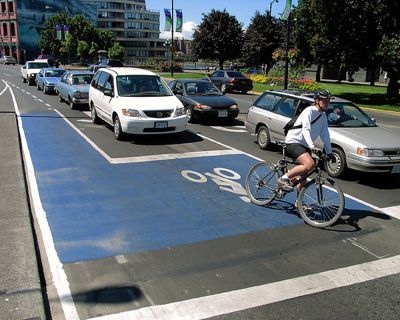The National Bike Summit begins tomorrow, bringing together an estimated 750 cycling advocates. They'll hear from NYCDOT Chief Janette Sadik-Khan, Transportation Secretary Ray LaHood, and Interior Secretary Ken Salazar, and they'll descend on Congress in droves, plastic bike pins fastened to their lapels, to deliver a message about safe cycling access.

We'll be covering the Bike Summit like other Washington reporters cover the State of the Union. For people who care about sustainable transportation, this event is a high point of the year.
As bicycling infrastructure improves, advocates refine their demands. These days, the call is not just for bike lanes, but separated bike lanes. Bike Summit attendees are sure to be talking about it. Yesterday, Streetfilms released a new video about floating parking and separated cycletracks. And last month, Harvard's School of Public Health released a study about the superior safety of separated bike tracks.
So why does the American Association of State Highway Transportation Officials still advise against cycle tracks on safety grounds? AASHTO's design manual is the "bible" used by traffic engineers and planners around the country, along with the FHWA's Manual on Uniform Traffic Control Devices, and it can be hard for localities to get approval -- or funding -- for projects that deviate from the prescriptions laid out in these guides.
A group of urban transportation officials, called Cities for Cycling, has been working to update AASHTO's Bikeway Design Standard Manual and the MUTCD for years to include better cycling infrastructure. Eric Gilliland, executive director of the National Association of City Transportation Officials, the sponsoring organization for Cities for Cycling, says the Harvard study confirms the benefits of separated bike lanes. "The trend, it seems, in bikeway planning is to provide more of a buffer between bicycle traffic and main street traffic, from a safety standpoint but also from an encouragement standpoint," Gilliland said.
Portland, in particular, has latched on to the concept of separated bike infrastructure, hoping it will attract hesitant cyclists, Gilliland said.
The problem with current guidelines, Gilliland said, is that they are not updated very often and do not consider European innovations. Cities for Cycling has been working to lobby the organization to adopt some of the more cutting-edge innovations being put in place in trailblazing cities.
AASHTO's standards do allow for some interpretation by engineers. Places like New York, San Francisco, Portland and Washington have "really been pushing the envelope," he said. But it can be tricky to use federal funds for projects that are not in the design manual. In the absence of federal design guidelines for roads and bikeways, states and localities adhere to AASHTO's guidelines in order to show that they're using "best practices" and to avoid liability.
Cities that choose to pursue avenues that are not specifically sanctioned must also undergo a time-consuming approval process. This can be difficult for smaller cities.
"If your budgets are small and you don’t have the research staff, trying to innovate is just a very difficult process," Gilliland said. "It’s not helping advance the cause of bicycling."
Cities for Cycling is working on an alternative to current guidelines. The Cities for Cycling manual will include the latest design innovations being adopted by American cities. Many of these practices have their orgins in Europe, Gilliland said, such as colored bike lanes, bike boxes and cycle signals. The group is hopeful their recommendations will be adopted for use by AASHTO and the FHWA.





